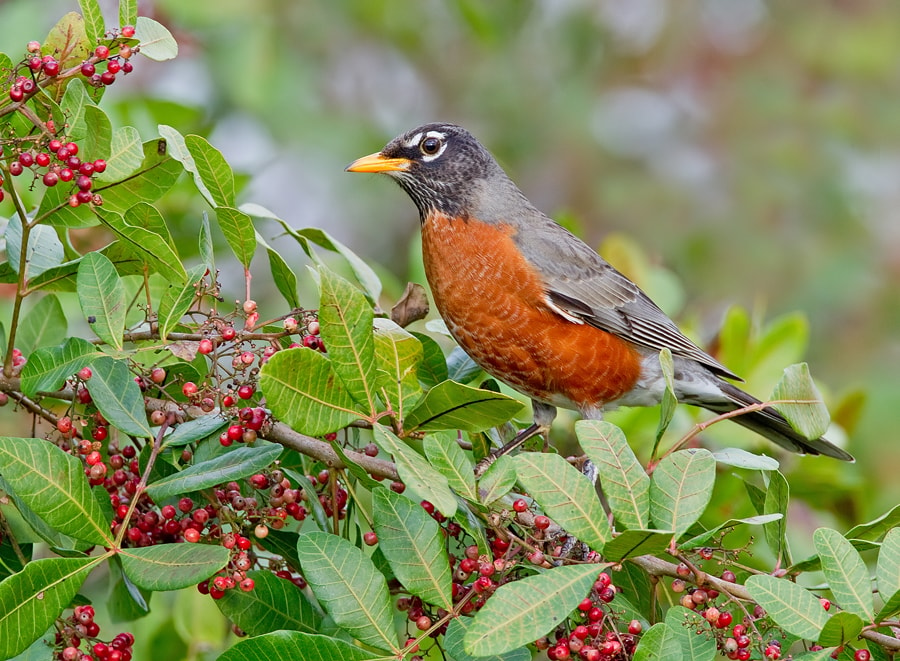Animal migration patterns are changing as humans alter the landscape, with those changes having potential impacts on public health and the phenomenon of migration itself, new research from the University of Georgia has shown.
The study, which was published in Philosophical Transactions of the Royal Society B, used mathematical models to explore the impacts of wildlife feeding on migration and disease.
Co-author Richard J Hall explained: "One familiar example for that would be American Robins, where widespread ornamental plantings of berry-bearing bushes in city parks and backyards means there's food for them in the winter, so an increasing fraction of them is staying north.
"That's a species that we know is an important host for maintaining West Nile virus in places such as New York City."

Ornamental, berry-laden plants are encouraging species such as American Robin to linger at northern latitudes year-round, rather than migrate south for winter (Paul Cools).
People provide food to wildlife both purposefully, such as with bird feeders or butterfly gardens, and unintentionally, as when scavengers (for example, gulls or Red Foxes) feed from bins or on discarded food items. Either way, access to new food resources, especially if they're available all year round, can cause some normally migratory species to resist their natural urges and stay put.
Many animals migrate to avoid harsh winter conditions or to follow available food as the seasons change. But migration can have another important benefit. By allowing animals to escape from habitats where parasites have accumulated and by weeding out infected individuals that are not able to survive the journey, migration can reduce infection in animal populations.
When human-provided food resources allow some animals to forego migration and form resident populations, the consequences can be serious. For one thing, by the time migrants return, resident individuals may already be taking up breeding territories and resources, putting the migrants at a competitive disadvantage. Furthermore, the migrants become exposed to infection by parasites carried by their resident congeners.
"When you get resident populations forming, you might extend the parasite transmission season, and additionally if those residents are supported by food subsidies through the winter, the infected individuals might be more likely to make it through," added Hall. "So now these migrants are returning to areas where there's already a larger number of infected individuals, so those mechanisms for escaping parasitism become less effective."
Another concern is that resident animal populations with supplemented diets might support more virulent parasites.
Hall commented: "If you think about it from the parasite's perspective, killing too many of their hosts reduces the chances of onward transmission and could cause them to die out. So parasites that rely on migratory animals may have evolved to be more benign to their hosts during their strenuous migratory journeys."
If supplemental food allows some animals to forego the rigors of migration and at the same time helps them survive infection, these resident populations might support the transmission of parasites that are more lethal to migrants.
"Migration is considered to be a threatened phenomenon by some because of the many barriers resulting from human land use and activities," continued Hall. "Providing food and shelter for wildlife in our backyards provides us with an important connection with the natural world, with associated benefits for our wellbeing and engagement with conservation issues. I don't want to say to people, 'Stop bird feeding,' but rather to adopt practices to ensure its benefits for people and wildlife alike."
There are steps people can take to minimise the unintended consequences. For example, planting native species that have a fruiting or flowering period that co-evolved with native birds. To prevent disease, those who use bird feeders should regularly sweep out seed husks and clean feeders and bird baths. It also helps to place feeders far apart from each other to reduce exposure to infectious pathogens.
Reference
Brown, L M, and Hall, R J. 2018. Consequences of resource supplementation for disease risk in a partially migratory population. Philosophical Transactions of the Royal Society B: Biological Sciences; DOI: 10.1098/rstb.2017.0095

